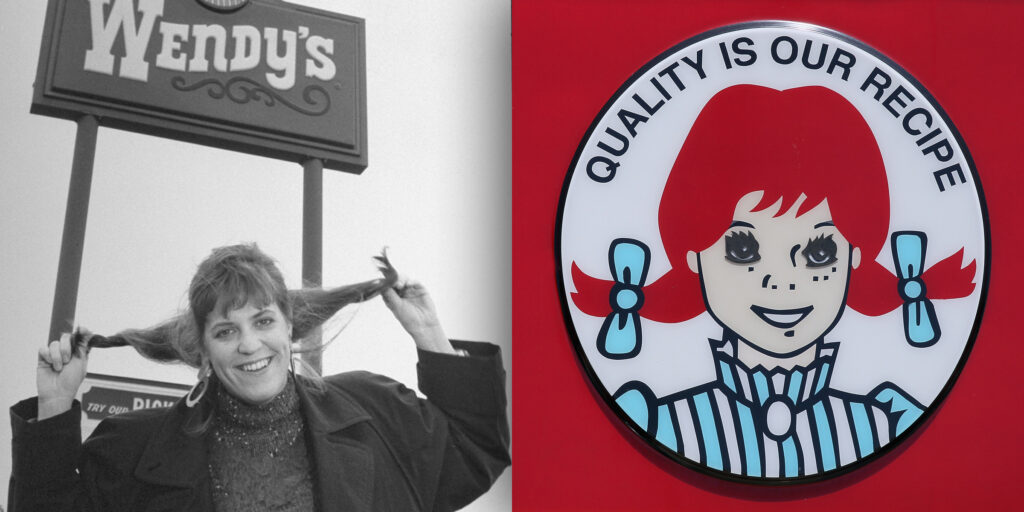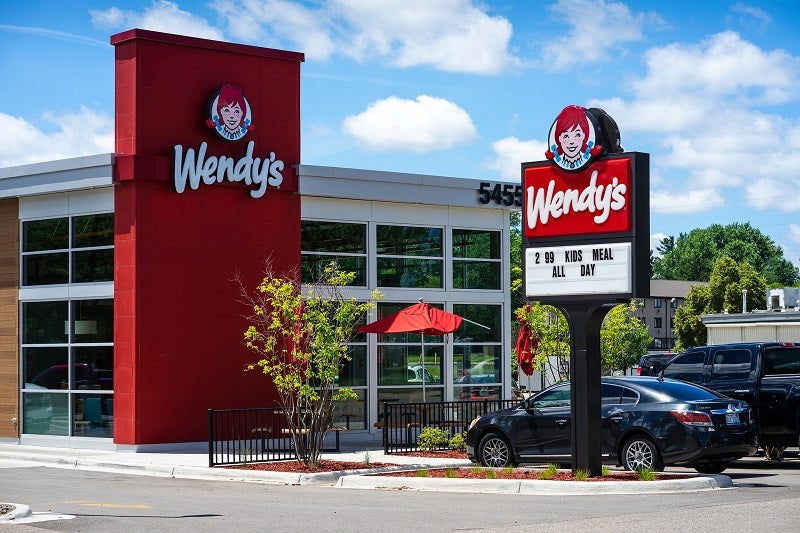Wendy’s is a fast-food restaurant chain that was founded in 1969 in Columbus, Ohio, by Dave Thomas. The company is known for its square-shaped burgers, “old-fashioned” style hamburgers, and its signature Frosty dessert. Today, Wendy’s is one of the largest quick-service restaurant chains in the world, with over 6,700 locations in 30 countries.
The name “Wendy’s” was inspired by Dave Thomas’s daughter, who was also named Wendy. The company’s logo features a cartoon image of a young girl with pigtails, which is meant to represent Wendy.
Wendy’s menu features a variety of items, including burgers, chicken sandwiches, salads, fries, and soft drinks. The company is also known for its value menu, which includes items like the Junior Bacon Cheeseburger and the 4 for $4 meal.
In addition to its menu offerings, Wendy’s is also known for its marketing campaigns, which have included slogans such as “Where’s the beef?” and “Quality is our recipe.” The company has also been involved in various charitable initiatives, including the Dave Thomas Foundation for Adoption, which helps children in foster care find permanent homes.
Overall, Wendy’s is a well-established fast-food chain that is known for its quality food, value menu, and innovative marketing campaigns. The company has a loyal customer base and continues to expand its reach both domestically and internationally.
Founding History of Wendy’s
Wendy’s was founded in 1969 by Dave Thomas, an entrepreneur who had previously worked in the fast-food industry. Thomas had started his career in the food industry at the age of 12, working at a restaurant in Kentucky. He later worked for Kentucky Fried Chicken (KFC) as a manager and helped the company expand its operations.
In 1968, Thomas decided to start his own restaurant chain. He chose the name “Wendy’s” after his daughter, who was also named Wendy. The first Wendy’s restaurant opened in Columbus, Ohio, on November 15, 1969. The restaurant was located at 257 East Broad Street and had a unique design, featuring a prominent roofline and a sign that read “QUALITY IS OUR RECIPE.”

Wendy’s menu featured a selection of burgers, fries, and soft drinks, as well as a signature item known as the Frosty, which was a frozen dairy dessert. One of the key features of Wendy’s burgers was that they were square-shaped, which set them apart from the round burgers served by other fast-food chains.
In the early years, Wendy’s faced stiff competition from other fast-food chains, including McDonald’s and Burger King. However, the company’s unique menu offerings and marketing campaigns helped it establish a loyal customer base. One of the most famous marketing campaigns was the “Where’s the beef?” campaign, which was launched in 1984 and featured an elderly woman asking that question while looking at a tiny hamburger patty on a large bun at a fictional fast-food chain. The campaign was a huge success and helped Wendy’s gain even more popularity.
Over the years, Wendy’s continued to expand its menu and add new items, including chicken sandwiches, salads, and more. The company also introduced a value menu, which included items like the Junior Bacon Cheeseburger and the 4 for $4 meal.
In addition to its menu offerings, Wendy’s has also been involved in various charitable initiatives. In 1992, Dave Thomas founded the Dave Thomas Foundation for Adoption, which helps children in foster care find permanent homes. The foundation has raised millions of dollars and helped thousands of children find families.
Although Dave Thomas passed away in 2002, his legacy lives on through Wendy’s and the Dave Thomas Foundation for Adoption.
Revenue Streams of Wendy’s – How does Wendy’s make money?
Wendy’s generates revenue from various sources, including restaurant sales, franchising, and licensing.
Restaurant Sales: This is the primary source of revenue for Wendy’s. The company owns and operates numerous restaurants, where customers can purchase food and beverages. The menu features a variety of items, including burgers, chicken sandwiches, salads, fries, and soft drinks. The company offers both dine-in and drive-thru options to its customers. Wendy’s uses a combination of traditional and digital advertising to attract customers to its restaurants and increase sales.
Franchising: Wendy’s also generates revenue by franchising its brand to independent operators. Franchisees pay an initial fee to open a Wendy’s restaurant and then pay ongoing royalties based on a percentage of sales. Franchisees are responsible for the day-to-day operations of their restaurants, including hiring and training employees, managing inventory, and marketing their businesses. Wendy’s provides support to its franchisees, including training, marketing, and ongoing operational assistance.
Licensing: Wendy’s also generates revenue through licensing agreements. The company licenses its brand to third-party manufacturers to produce and sell products such as frozen meals, snacks, and beverages. Wendy’s also licenses its logo and other intellectual property to companies for use on products such as apparel, toys, and accessories. These licensing agreements provide additional revenue streams for Wendy’s without requiring the company to operate its own manufacturing or retail operations.
Digital Channels: Wendy’s also generates revenue through its digital channels, such as its mobile app and online ordering system. These channels allow customers to order food and beverages for delivery or pickup. Wendy’s also offers mobile coupons and other promotions to incentivize customers to use its digital channels. The company generates revenue through transaction fees and commissions on orders placed through these channels.
Overall, Wendy’s uses a combination of restaurant sales, franchising, licensing, and digital channels to generate revenue and grow its business. By diversifying its revenue streams, the company can reduce its reliance on any one source of income and mitigate risk.
Marketing Strategies of Wendy’s
The company’s success can be attributed to its innovative marketing strategies that have helped it differentiate itself from its competitors and build a loyal customer base. In this article, we will take a closer look at some of Wendy’s most effective marketing strategies.
Brand Campaigns – Example “Where’s the Beef?” Campaign
One of Wendy’s most iconic marketing campaigns was the “Where’s the beef?” campaign, which was launched in 1984. The campaign featured an elderly woman looking at a tiny hamburger patty on a large bun at a fictional fast-food chain and asking, “Where’s the beef?” The campaign was a huge success and helped Wendy’s gain even more popularity. It was a clever way to highlight Wendy’s use of fresh, never frozen beef in their burgers and differentiate themselves from competitors who used frozen beef patties.
Social Media Engagement
Wendy’s has a strong presence on social media, particularly Twitter. The company’s social media team is known for their witty responses and humorous banter with other brands and customers. This has helped Wendy’s stand out from other fast-food chains and generate buzz on social media. Wendy’s has also launched successful social media campaigns, such as the #NuggsForCarter campaign, which offered a year’s worth of free chicken nuggets to a teenager who received 18 million retweets.
Value Menu
Wendy’s introduced its value menu, known as the “Right Price Right Size Menu,” in 2013. The menu offered items starting at 99 cents, making Wendy’s more affordable for budget-conscious customers. The menu was a hit and helped drive traffic to Wendy’s restaurants. The company has continued to offer value menu items, including the popular 4 for $4 meal, which includes a burger, fries, nuggets, and a drink.
Limited-Time Offers
Wendy’s regularly introduces limited-time offers (LTOs) to its menu, which creates excitement among customers and drives sales. For example, Wendy’s introduced the Baconator in 2007 as a limited-time offer, and it became a permanent menu item due to its popularity. Wendy’s also introduced the Pretzel Bacon Cheeseburger and the Spicy Chicken Sandwich as LTOs, both of which were successful and have been brought back several times.
Sponsorships and Partnerships
Wendy’s has also used sponsorships and partnerships to promote its brand. For example, the company sponsored the NCAA basketball tournament, which helped increase its visibility among sports fans. Wendy’s has also partnered with companies such as DoorDash and Grubhub to offer delivery services to customers. These partnerships have helped Wendy’s reach new customers and increase sales.
In conclusion, Wendy’s has used a variety of marketing strategies over the years to differentiate itself from its competitors and build a loyal customer base. From iconic campaigns such as “Where’s the beef?” to engaging with customers on social media, Wendy’s has proven to be a master of marketing. By continuing to innovate and stay ahead of the curve, Wendy’s is sure to remain a favorite among fast-food fans for years to come.
Brand Campaigns of Wendy’s
Wendy’s has been successful in creating brand campaigns that are memorable, engaging, and effective at increasing brand awareness and driving sales. In this article, we will take a closer look at some of Wendy’s most successful brand campaigns.
“Where’s the Beef?”
The “Where’s the Beef?” campaign is one of Wendy’s most iconic and memorable brand campaigns. It was launched in 1984, at a time when fast food restaurants were all offering similar menu items. Wendy’s wanted to differentiate itself from competitors and emphasize the use of fresh, never-frozen beef in their burgers.
The campaign featured an elderly woman named Clara Peller, who starred in a series of television commercials. In the commercials, Clara would visit fictional fast food restaurants and be served a burger with a small beef patty on a large bun. She would then look at the burger and ask, “Where’s the beef?” The phrase became an instant hit and was soon used as a catchphrase across the country.
The campaign was a huge success, as it not only helped Wendy’s stand out from competitors but also increased sales. Wendy’s was able to leverage the campaign to emphasize the quality of their ingredients, specifically their use of fresh beef, which was a unique selling point for the brand.
The “Where’s the Beef?” campaign was not only a success in terms of sales but also became a cultural phenomenon. The phrase “Where’s the Beef?” was used in pop culture, in political campaigns, and even became the title of a book. Clara Peller, the star of the campaign, became a celebrity and appeared on numerous talk shows and in commercials.
Overall, the “Where’s the Beef?” campaign was a masterstroke of marketing by Wendy’s, as it helped the brand differentiate itself from competitors and became a cultural phenomenon. The campaign’s use of humor and memorable catchphrases helped cement Wendy’s place in popular culture and the minds of consumers.
“Fresh, Never Frozen”
The “Fresh, Never Frozen” brand campaign was launched by Wendy’s in 2011. The campaign was designed to emphasize the quality of the ingredients used in Wendy’s menu items, particularly its beef, which was never frozen.
The campaign featured Wendy’s founder Dave Thomas’ daughter, Wendy, as the spokesperson, emphasizing the company’s commitment to quality ingredients. The television commercials showed Wendy visiting one of Wendy’s suppliers, where she saw firsthand the process of selecting and preparing the beef used in Wendy’s burgers.
The campaign also included a social media component, with Wendy’s engaging with customers on Twitter and Facebook, answering questions about the quality of their ingredients and using the hashtag #NeverFrozen to further promote their use of fresh beef.
The “Fresh, Never Frozen” campaign was a hit with customers, as it highlighted Wendy’s commitment to quality and freshness. The campaign helped to differentiate Wendy’s from its competitors, who often use frozen meat in their burgers. By emphasizing the freshness of its ingredients, Wendy’s was able to position itself as a higher-quality option in the fast food market.
The campaign was also successful in terms of sales, with Wendy’s reporting a 3.2% increase in same-store sales during the first quarter of 2011. The success of the campaign led to Wendy’s continuing to use the “Fresh, Never Frozen” messaging in its advertising and marketing efforts for several years.
Overall, the “Fresh, Never Frozen” campaign was a successful brand campaign for Wendy’s. By emphasizing the quality of its ingredients and positioning itself as a higher-quality option in the fast food market, Wendy’s was able to differentiate itself from competitors and increase sales.
#NuggsForCarter
The #NuggsForCarter campaign was a social media sensation launched by Wendy’s in 2017. The campaign started with a simple tweet from a high school student named Carter Wilkerson, who asked Wendy’s how many retweets he would need to earn a year’s supply of free chicken nuggets.
Wendy’s responded with a challenge: Carter would need 18 million retweets to earn his free nuggets. Carter accepted the challenge and tweeted out his plea to the internet, asking for people to help him reach his goal.
The tweet quickly went viral, with people around the world joining the effort to help Carter reach his goal. The hashtag #NuggsForCarter began trending on Twitter, and the campaign became a social media sensation.
![]()
Wendy’s quickly embraced the campaign, tweeting out their support for Carter and even creating a dedicated website to track his progress. The campaign was also supported by a number of celebrities and brands, who tweeted out their support for Carter and helped spread the word about the campaign.
In the end, Carter fell short of the 18 million retweets needed to earn his free nuggets, but the campaign was still a huge success. Carter’s tweet became the most retweeted tweet of all time, and the campaign generated massive amounts of media coverage and social media engagement for Wendy’s.
The success of the campaign led Wendy’s to donate $100,000 to the Dave Thomas Foundation for Adoption, a non-profit organization that helps find permanent homes for children in foster care. Wendy’s also gave Carter his year’s supply of free chicken nuggets and created a special edition “Nuggs for Carter” t-shirt that was sold to raise money for the Dave Thomas Foundation.
Overall, the #NuggsForCarter campaign was a massive success for Wendy’s. The campaign was able to leverage social media to generate massive amounts of engagement and media coverage, while also supporting a worthy cause. The campaign also helped to further cement Wendy’s place as a brand that is willing to engage with its customers and embrace new forms of marketing and advertising.
“We Beefin?”
The “We Beefin?” brand campaign was launched by Wendy’s in 2018. The campaign was designed to promote Wendy’s commitment to using fresh, never frozen beef and to position the brand as the go-to destination for high-quality burgers.
The campaign kicked off with a series of humorous music videos, featuring Wendy’s rapping about their fresh beef and taking shots at their competitors. The videos featured catchy beats and clever lyrics, with lines like “If you’re square, you ain’t beefin'” and “Can’t trust that frozen beef, that ain’t right.”
The campaign also included social media components, with Wendy’s engaging with customers on Twitter and other platforms. Wendy’s created custom GIFs and memes to promote the campaign, and encouraged customers to share their own beef-related content using the hashtag #WeBeefin.
In addition to the music videos and social media components, the campaign also included a partnership with DoorDash, with Wendy’s offering free delivery for customers who ordered their burgers through the app.
The “We Beefin?” campaign was a hit with customers, who appreciated the humorous and irreverent tone of the ads. The campaign helped to differentiate Wendy’s from its competitors and position the brand as a higher-quality option in the fast food market.
The campaign was also successful in terms of sales, with Wendy’s reporting a 3.3% increase in same-store sales during the first quarter of 2018. The success of the campaign led Wendy’s to continue using the “We Beefin?” messaging in its advertising and marketing efforts for several years.
Overall, the “We Beefin?” campaign was a successful brand campaign for Wendy’s. By using humor and music to promote its commitment to fresh beef, Wendy’s was able to differentiate itself from competitors and increase sales. The campaign also demonstrated Wendy’s willingness to embrace new forms of marketing and advertising, and its ability to connect with customers through social media and other digital platforms.
Overall, Wendy’s has been successful in creating brand campaigns that are memorable, engaging, and effective at increasing brand awareness and driving sales. By emphasizing the use of quality ingredients and staying ahead of the curve with new menu items and social media campaigns, Wendy’s has proven to be a master of brand marketing.
Also Read: Marketing Mix And STP Analysis of McDonalds
Wendy’s vs McDonald’s – who’s doing it better?
Wendy’s and McDonald’s are two of the largest fast-food chains in the world, with both brands having a significant presence in the United States and many other countries around the world. While both companies offer similar types of food and drink, there are several key differences between the two brands.
One of the biggest differences between Wendy’s and McDonald’s is their menu offerings. While both brands offer hamburgers, fries, and soft drinks, Wendy’s has a more diverse menu that includes items like chili, baked potatoes, and a range of salads. Wendy’s is also known for its Frosty desserts, which are a unique menu item that McDonald’s does not offer.
Another key difference between the two brands is their marketing and advertising strategies. Wendy’s has gained a reputation for its clever and irreverent social media presence, with the company frequently engaging with customers and taking shots at its competitors. McDonald’s, on the other hand, has a more traditional marketing strategy, focusing on big-budget ad campaigns and promotions like the McDonald’s Monopoly game.
In terms of pricing, Wendy’s tends to be slightly more expensive than McDonald’s, with its menu items generally costing a bit more than comparable items at McDonald’s. However, Wendy’s has also gained a reputation for using higher-quality ingredients than many of its competitors, which may justify the higher prices.
When it comes to customer experience, both brands have their strengths and weaknesses. Wendy’s is known for its fast and efficient service, with many customers praising the chain for its speed and accuracy. McDonald’s, on the other hand, has a reputation for its consistency and reliability, with customers knowing exactly what to expect when they visit a McDonald’s location.
Overall, both Wendy’s and McDonald’s are successful fast-food chains that have their own unique strengths and weaknesses. While Wendy’s is known for its diverse menu and clever marketing, McDonald’s is known for its consistency and reliability. Ultimately, the choice between the two brands comes down to personal preference and individual taste.
To read more content like this, subscribe to our newsletter



